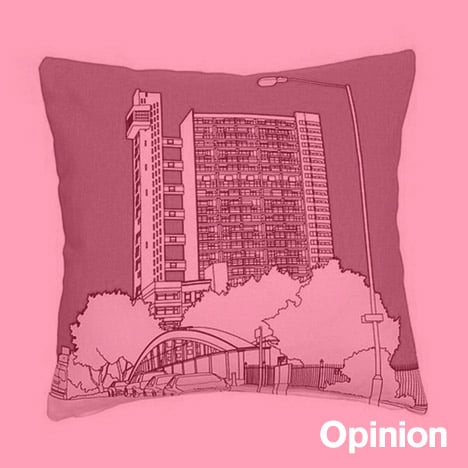
"Cute nostalgia sits strangely with Brutalism"
Opinion: Sam Jacob ponders the paradox of solid, concrete Brutalist architecture printed onto soft furnishings in this week's column.
Most evenings you'll find me reclining on a couch propped up on cushions gawping at the TV. After another hard day at the office it's great to sit on something soft and stretch my legs out. But sometimes it strikes me as strange that the very thing that makes it so comfortable - those cushions that prop up various parts of my body - are cushions depicting the opposite of softness. Against the small of my back there's Park Hill, a giant council estate built in Sheffield in between 1957 and 1961. And propping up my head is everybody's favourite 1960s concrete megastructure, The Barbican.
I'm aware that me lounging on soft versions of 1960s utopian architecture holed up in an actual real life Lubetkin tower block while I spoon my Ben & Jerry's is an odd scene. But I don't think I'm the only one caught up in this contemporary phenomenon. If you search hard enough you could probably furnish your entire home with cushions, tea towels and crockery depicting the high points of British Modernism. And it's not just any old Modernism, but hulking great concrete Brutalism.
There's something strange going on here. All this giant, hard stuff is turned into cosy domesticity. It's as though Cath Kidston, the queen of nostalgic domesticity, has swallowed a copy of Towards An Architecture or fallen through a rift in time and found herself participating at the 9th Congress of C.I.A.M.
Such cute nostalgia sits strangely with Brutalism, which was never a project about the past, but about the future. It was part of the post-war reconstruction of the UK and was driven by a set of social and political concerns that informed its raw architectural form. Brutalism emerged in the 1950s as a re-boot of Modernist principles by a generation who believed the movement's original intentions had been watered down. In projects like Park Hill, The Barbican and the soon-to-be-demolished Robin Hood Gardens, a younger generation built, for their municipal clients, a range of radical projects that read as much as social infrastructure as they did architecture.
Of course our era is entirely different. The Modern project is impossible in any real sense, given our political and economic choices. Its vision of a New Jerusalem, of architecture in the service of public interest and a function of the welfare state, is not just out of step, but out of time. These concerns have been entirely subsumed by the market. Architecture and the public services it once worked for have been given over to the private sector. And any remaining vestiges of welfare-ism are in the process of being finally dismantled.
What passes for Modernism now is simply an aesthetic, not an ethic (although it's true to say that this might have been the case for very much longer. After all, Reyner Banham, the critic most involved in the Brutalist cause published The New Brutalism: Ethic or Aesthetic? way back in 1966). We might argue that architecture's use of Modern or Brutalist aesthetic language is itself nostalgic: an image, rather than a real form, of Modernism. We might argue too that this kind of nostalgia masquerading as reality is far more dangerous than the surreal nostalgias represented by tea cosies in the shape of the Balfron Tower.
These Etsy-fied versions of British Modernism are, of course, nostalgic. They cite a place and time that is beyond our reach. They show projects whose ambition to remake the world through architecture is now impossible. And they do it in an Illustrator-outlined, pastel-coloured manner that renders them far cuter than their rough-poured and bush-hammered subjects.
Unlike many who claim to guard the flame of Brutalism, I have no problem with its return as nostalgia and nu-craft. Sure, it represents a new kind of gentrified, privatised, individual absorption of Modernism. But it does it at a time when British Modernism remains controversial. The London Borough of Tower Hamlets' decision to blow up Robin Hood Gardens, the partial re-making of Park Hill and the plans to extend the Southbank Centre all represent contemporary responses to the built legacy of Brutalism. And of course, many of these projects remained publicly controversial and politicised. We see this in Policy Exchange's recent report Making Housing Affordable, in which the Conservative think tank called for these housing projects to be torn down and replaced by traditional homes and streets.
The Etsy-fication of British Modernism represents a strange domestication of the Modern project. But, I'd argue, it might serve another purpose too. Could we read these objects as soft and comforting Ghosts of Architecture Past? Perhaps it's here that architecture's political and social ambitions lie dormant, not only as reminders of another time but ready to rise again from the couch and kitchen.
Sam Jacob is a director of architecture practice FAT, professor of architecture at University of Illinois Chicago and director of Night School at the Architectural Association School of Architecture, as well as editing www.strangeharvest.com.